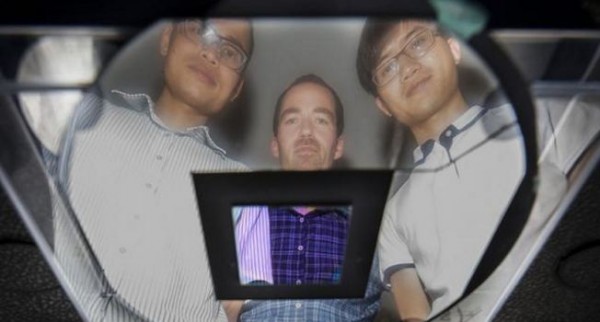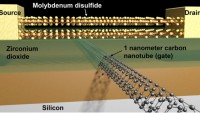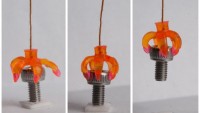Perovskite Solar Cell Production Breakthrough could Lead to Cheaper Electricity
| Arthur Dominic Villasanta | | Nov 16, 2016 10:58 PM EST |
(Photo : Jack Fox/ANU) ANU Ph.D. student The Duong, Dr.Tom White and Ph.D. student Jun Peng with their semi-transparent preovskite solar cell.
Researchers at The Australian National University (ANU) have developed a new method of fabricating high efficiency semi-transparent perovskite solar cells in what's being called a breakthrough that could lead to more efficient and cheaper solar electricity.
The new fabrication method significantly improved the performance of perovskite solar cells. It involves adding a small amount of the element indium into one of the cell layers during fabrication. That stands to increase the cell's power output by as much as 25 percent.
Like Us on Facebook
Perovskite solar cells are a unique type of solar cell that can combine with conventional silicon solar cells to produce more efficient solar electricity.
"We have been able to achieve a record efficiency of 16.6 percent for a semi-transparent perovskite cell, and 24.5 percent for a perovskite-silicon tandem, which is one of the highest efficiencies reported for this type of cell," said Dr. Tom White from the ANU Research School of Engineering.
Perovskite solar cells are very good at making electricity from visible light (blue, green and red) while conventional silicon solar cells are more efficient at converting infrared light into electricity, said Dr. White.
"The prospect of adding a few additional processing steps at the end of a silicon cell production line to make perovskite cells is very exciting and could boost solar efficiency from 25 percent to 30 percent," said Dr. White.
He noted that by combining the perovskite cell and the silicon cell, the team was able to make much better use of the solar energy and achieve higher efficiencies than either cell on its own. While perovskite cells can improve efficiency, they aren't yet stable enough to be used on rooftops, however.
Dr. White said the new fabrication technique could help develop more reliable perovskite cells.
The research placed ANU among a small group of labs around the world with the capability to improve silicon solar cell efficiency using perovskites.
The development builds on the state-of-the-art silicon cell research at ANU and is part of a $12.2 million "High-efficiency silicon/perovskite solar cells" project led by University of New South Wales and supported by $3.6 million of funding from the Australian Renewable Energy Agency.
Research partners include Monash University, Arizona State University, Suntech R&D Australia Pty Ltd and Trina Solar.
TagsAustralian National University, perovskite solar cells, Dr. Tom White, indium, perovskite-silicon tandem, new fabrication technique
©2015 Chinatopix All rights reserved. Do not reproduce without permission
EDITOR'S PICKS
-

Did the Trump administration just announce plans for a trade war with ‘hostile’ China and Russia?
-

US Senate passes Taiwan travel bill slammed by China
-

As Yan Sihong’s family grieves, here are other Chinese students who went missing abroad. Some have never been found
-

Beijing blasts Western critics who ‘smear China’ with the term sharp power
-

China Envoy Seeks to Defuse Tensions With U.S. as a Trade War Brews
-

Singapore's Deputy PM Provides Bitcoin Vote of Confidence Amid China's Blanket Bans
-

China warns investors over risks in overseas virtual currency trading
-

Chinese government most trustworthy: survey
-

Kashima Antlers On Course For Back-To-Back Titles
MOST POPULAR
LATEST NEWS
Zhou Yongkang: China's Former Security Chief Sentenced to Life in Prison

China's former Chief of the Ministry of Public Security, Zhou Yongkang, has been given a life sentence after he was found guilty of abusing his office, bribery and deliberately ... Full Article
TRENDING STORY

China Pork Prices Expected to Stabilize As The Supplies Recover

Elephone P9000 Smartphone is now on Sale on Amazon India

There's a Big Chance Cliffhangers Won't Still Be Resolved When Grey's Anatomy Season 13 Returns

Supreme Court Ruled on Samsung vs Apple Dispute for Patent Infringement

Microsoft Surface Pro 5 Rumors and Release Date: What is the Latest?












